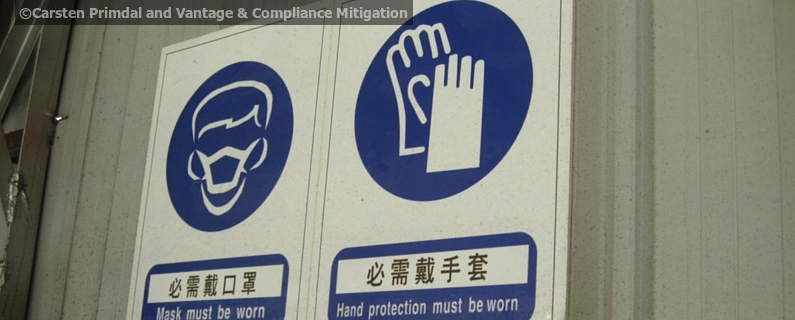The recent blasts in China’s manufacturing sector have turned the world’s eyes towards that country’s safety standards and activities. The social tragedies in the affected areas have been significant, as several hundred people were killed, and hundreds more were rendered homeless when the blasts leveled whole communities.
For the world’s product manufacturers, Chinese suppliers play a large part in the economic success of their production chains, providing parts and materials at low prices and in immense quantities. Understanding what goes wrong in any factory can inform every international producer about how to choose and contract with factories that demonstrate strong safety and manufacturing practices. No international manufacturer should risk the loss of corporate reputation and stature that might occur if they are involved with Chinese facilities that are not in compliance with safety rules and regulations.
Climate + Behaviours = Safe Workplaces:
A 2015 research study reviewed safety practices in the Chinese manufacturing sector to determine connections between the individual factory’s safety “culture” and injuries to workers. The study identified “safety climate” and “safety behavior” as principle features of successful (and unsuccessful) factory practices. “Work related injuries” were described as “any injury that happened while a worker was at the location of any employer facility.” The study included a survey of over 3,900 workers from 42 manufacturing facilities in Zhongshan City.
“Safety climate” was described as the “sum of the employee’s shared perceptions of policies, procedures and practices relating to safety.” Significant factors that create and maintain an appropriate safety climate are management commitment; safety supervision; coworker support and safety training (including awareness, knowledge, communications and policy comprehension).
“Safety Behavior” can be divided into two types: “safety participation” (the engagement of employees in safety practices and cultures within the factory), and “safety compliance” (complying with safety procedures and performing work in a safe manner). The study addressed three dimensions of safety behavior: safety compliance and participation in corporate systems; employee usage of personal protective equipment (PPE), and safety initiatives within the workforce.
The study found empirical links between safety climate, safety behavior and reduced (or elevated) incidents of worker injuries. Safety supervision (trained supervisors communicating safety expectations clearly to subordinates) was strongly connected to employee use of PPE and compliance with safety policies. Management commitment to safety policies and procedures had the strongest connection to safety compliance (worker conformance with those standards), so it also had a strong effect on the occurrence of occupational injuries. Like other studies mentioned, this study concluded that management commitment to employee safety is critical to employee safety performance on the job.
China is Not Alone With Safety Challenges:
Other international supply chain factories share China’s challenges. In Bangladesh, safety failures have caused thousands of deaths in production factories. In 2012, a fire broke out in the Tazreen Fashion factory, killing 117 employees, mostly young women. The subsequent investigation revealed that the facility lacked emergency exits and fire extinguishers, and employee staircases had been locked to prevent theft. Five months later, the Rana Plaza building in Bangladesh collapsed, killing over 1,100 people. Garment factories on the top floors of the plaza had remained open, even though the buildings were showing large cracks in the load bearing walls in the days before the tragedy.
China’s Government Has Improved Industrial Sectors:
China has, in the past, addressed and remediated problems within its big industries. Most notably, the coal mining industry suffered thousands of worker deaths in the early 2000s. Intense government interventions have reduced deaths in that industry from between 6,000 and 7,000 in 2005 to under 1,000 in 2014.
China has demonstrated its willingness and ability to address critical safety factors within its industrial sectors. The recent explosions are indicators that this aspect of the Chinese economy is now ripe for evaluation and modification. While that process revs up, and to identify existing Chinese manufacturing suppliers that happily comply with Chinese and international safety standards, contact me today.
If you would like to know more, you can download a free report “8 Problems Businesses face when sourcing from China here.
https://vantagecompliance.com/8-problems-businesses-face-when-sourcing-goods-from-china-bg/
This blog was written by Carsten Primdal, an independent consultant who helps businesses that have manufacturing done overseas – especially in China – to minimise supply chain risk.Drawing on years of on-the-ground experience and a strong understanding of the cultural and commercial context, Carsten is passionate about helping his clients gain greater control over the risks most companies face knowingly or unknowingly.
Urgent issues? Questions? Concerns? If you are considering/already buying from Chinese factories and would like more information, please feel free to contact us for an obligation free talk.
I can be reached at carsten@vantagecompliance.com or on (+61) 413 089 020
You may also like to read some of my other blogs. They can be found here:
China Manufacturing Industry Challenges Trigger Inspections, Consequences
Risk Mitigation Can Prevent Chinese Supply Chain Disruption
Tips and Traps of Contracting in China
Keeping Your Supply Chain Green: Avoiding the Environmental Polluters when sourcing in China
Ensure Timely Contract Compliance with a Chinese Supply Chain Expert
Two Key Questions To Answer Before Onboarding Your Chinese Manufacturing Supplier
Off-Shore Manufacturer’s Certificates Require Credibility
Factory Planning Principles Improve Supply Chain Quality
Mitigating Risk of Quality Fade in Overseas Manufacturing Facilities
How to Assure your “Green” Supply Chain in China
ChAFTA Opens Doors for increase in China-Australia Business relations
China Verification for Your Manufacturing Supplier Needs
Australian Industry Agreements Encourage More Chinese Factory Verifications
China Factory Verification: Check Before You Buy
Frozen berry recall highlights potential supply chain risks in offshore production



